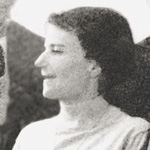The glimmer of a diamond
Head of the Gargamelle group at the Laboratory of the Ecole Polytechnique in Paris, of which she was deputy director from 1973 to 1985, Violette Brisson played an active part in the discovery of neutral currents. Today, she is director at the French research laboratory LAL in Orsay.
 “I couldn’t begin this account without mentioning my colleagues from the Ecole Polytechnique who are no longer with us: André Lagarrigue, without whom there would be no story to tell, André Rousset, who was in charge of the CERN group at that time, and Paul Musset, who also played a very important role in the discovery.
“I couldn’t begin this account without mentioning my colleagues from the Ecole Polytechnique who are no longer with us: André Lagarrigue, without whom there would be no story to tell, André Rousset, who was in charge of the CERN group at that time, and Paul Musset, who also played a very important role in the discovery.
Neutral currents, whose existence was extremely hypothetical in those days, were only eighth on the planned list of experiments for Gargamelle. It was not until 1972 that the theorists drew the Collaboration’s attention to the work of Gerard ’t Hooft, who had predicted their existence in the framework of the new theories unifying the electromagnetic and weak forces.
The associated research was initiated by Antonino Pullia in Milan, who very soon presented us with about 30 possible events, or ‘candidates’, which generated a lot of excitement. Several physicists, including myself at the Ecole Polytechnique, together with Pierre Petiau and Louis Kluberg, threw themselves into research on the subject. We very quickly found candidate events for neutral currents but I was still very doubtful until a meeting at CERN in May 1972, when all the laboratories involved in the Collaboration presented photos of their candidates. I came away firmly convinced, as did many of my colleagues. That was when we really began to get excited because, after finding so many semi-precious stones in our experiments over the past ten years, we were now starting to glimpse a genuine diamond!
This marked the start of an intense phase of work, which involved sorting through some 100,000 photos and analysing events, as well as studying their background (since neutron interactions can be confused with neutral currents). In December 1972 there was great rejoicing when virtually incontestable proof of another type of neutral current, the ‘leptonic’ neutral current, was found in Aachen. The theorists were ecstatic. We re-examined the pictures (four times!) to make sure that we hadn’t missed anything. Later on, our analysis of nine times the number of shots produced only two further candidates, which tied in with the theoretical calculations.
We were euphoric as this confirmed the existing evidence for so-called ‘hadronic’ neutral currents. However, extensive work was needed at the beginning of 1973 to calculate the background for these hadronic currents. Once the simulation programmes of Dieter Haidt and Jean-Pierre Vialle and the more simple calculations of André Rousset, Don Perkins and Antonino Pullia, to name but a few, had been completed, there was no longer any shadow of a doubt. With the unanimous agreement of the whole Collaboration, Paul Musset presented the results at CERN in July 1973 and they were published in early September.
Despite the enthusiasm of the entire community, some our of colleagues remained sceptical. We ourselves were confident, however, especially since the American team at Fermilab had also found candidates. That confidence lasted until one day in October 1973, when André Lagarrigue received a telephone call informing him that Fermilab’s candidates had disappeared. I can still remember the anguish in his voice when he called to tell me that our colleagues ‘over there’ could no longer see anything and wondered whether we could have forgotten something or made a mistake. Doubts began to creep in…
In order to convince our detractors, we took data that checked the background results obtained by Dieter Haidt. We even allowed ourselves to make jokes about our American colleagues’ ‘alternating currents’. All doubt was finally removed with the discovery of two further leptonic neutral currents at the beginning of 1974. The Americans’ neutral currents gradually re-emerged and, in summer 1974, the existence of the phenomenon was officially recognized.
The discovery gave rise to many neutrino experiments at CERN and in the United States, which measured all the parameters of the electroweak interaction with increasing precision. The discovery of the W and Z bosons at CERN in 1983 then confirmed the electroweak theory once and for all.
Unfortunately, Gargamelle was not destined to ring the Nobel chimes for André Lagarrigue, the ‘father’ of the experiment, who passed away in 1975 before he could be considered for the Prize. Having been ‘put to rust’ for several years, the bubble chamber was finally erected at CERN as a piece of sculpture. As for Gargamelle’s ‘workers’, we were sometimes badly treated or forgotten, but we also experienced the elation and joy of a very great discovery and we have always remained true friends. What more could anyone ask for?”

